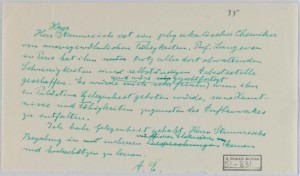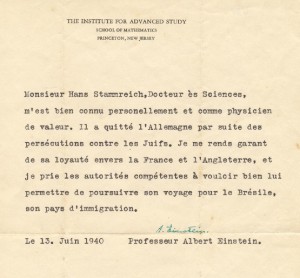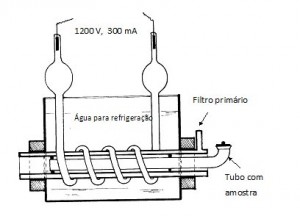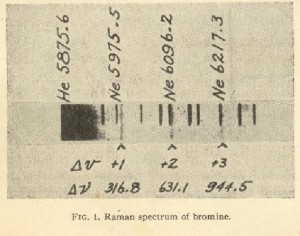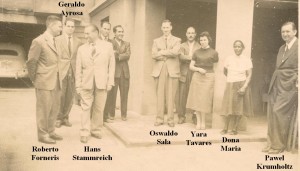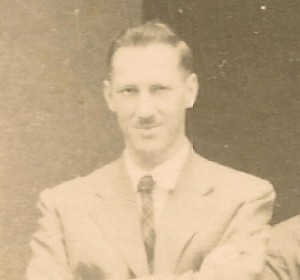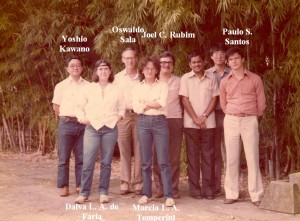The Laboratory
Introduction
Professor Hans Stammreich introduced Raman spectroscopy in Brazil, in 1940s, at the Department of Physics, Faculty of Philosophy, Sciences and Letters, University of São Paulo (USP), giving rise to the current Laboratory of Molecular Spectroscopy (LEM) of the Institute of Chemistry; which survived and grew thanks to the solid foundation he established.
Hans Stammreich was born in Remscheid, Rhineland, Germany (07.16.1902). He finished his university studies in Physics, Chemistry and Physical Chemistry in the Universities of Heidelberg and Berlin, in 1924, the defense of doctoral thesis “desensitization of Silver Bromide Emulsions”, approved with the words “Magna Cum Laude” , receiving the degree of Doctor of Philosophy. His thesis was examined by Professors Bodenstein (Physical Chemistry), Haber (Chemistry) Nernst (Physics) and Köhler (Philosophy).
He joined the university career in 1925 as Assistant Professor of A. Miethe, working initially in determining microquantidades gold and then with the theoretical basis of photographic processes, espectrophotography and spectral photometry. He conducted purely scientific work on the spectral sensitivity and the validity of Einstein’s law of photochemical reactions in solutions of silver halides. In 1930 He was in charge of the organization and direction of Section Spectroscopy and Spectral Analysis of the Polytechnic School in Berlin-Charlottenburg, a position he held until 1933, when with the rise to power of Hitler took refuge in France.
Introduced by Prof. Albert Einstein, He continued his work with Prof. Paul Langevin, at the “Ecole Municipale de Physique et Chimie”, and then with Prof. Charles Fabry, at the Institute of Optical Research Sorbonne. Applying physical methods in chemistry. He devoted himself to the construction of spectrographs, spectrophotometers, and also discharge lamps in metal vapors, obtaining records of patents that were acquired by Philips Company, Holland. In 1933 he was invited by the government of Iran to install a laboratory for physical and chemical research at Tehran University and the Academy of Sciences of the USSR to give a course of spectrophotometry in the Leningrad Institute of Optics.
His ability was recognized by Albert Einstein who wrote a letter of recommendation for an opportunity in Palestine.
Mr. Hans Stammreich is a physical chemist with extraordinary capabilities. The Professor Langevan created for him a vacancy for an autonomous work in Paris, despite all the difficulties reigning there. I would be very pleased and very justified if one offered it an opportunity in Palestine to demonstrate their knowledge of and capabilities in support of the development work.
I had the opportunity to know and appreciate the talent of Mr. Stammreich in various oral discussions.
A.E.
In 1940, with the invasion of France, with the intervention of Prof. Aloysio Castro He came to Brazil. Again, Albert Einstein wrote a letter of recommendation.
Translation: Hans Stammreich, Doctor of Science, is well known by me personally and as a valuable physicist. He left Germany as a result of the persecution of the Jews. I will guarantee their loyalty to France and England, and I ask the authorities to allow him kindly continue your trip to Brazil, the country of immigration.
June 13, 1940
Professor Albert Einstein
Initially, due the experience we had in gas discharge tubes (used in neon signs) “Nihil Neon” industry, He was hired by the Department of Physics, Faculty of Philosophy, Sciences and Letters, University of São Paulo, in 1943 De 1947 to 1959 he conducted the Chair of Higher Physics, passing the Contract Professor of Molecular Physics Course, always directing the Laboratory of Molecular Spectroscopy
The huge interest that there was by Raman spectroscopy, which at the time was made using mercury arc as excitation source, who did almost all substances have been studied, with the exception of color, photochromic and fluorescent. Prof. Stammreich viewed a new perspective for this spectroscopy with excitation by low energy photons, ie, radiation in the red region using helium lamps, allowing to overcome the mentioned problems.
The international reputation of Prof. Stammreich was not only due to the development of experimental techniques, but mainly by the high level of his work and his extraordinary vision in the choice of themes.
As Professor He always paid special care in the preparation of courses making the experimental classes were completely interlocked with the theoretical teaching and illustrating his lectures with practical demonstrations.
The first Raman spectrograph, in Brazil, “Lane-Wells”, was purchased by the Department of Physics in 1947. The excitation source consisted of two arcs of mercury. the dispersive system consisted of three glass prisms and the spectrum was recorded in photographic film.
The use of Raman radiation at 435.8 nm, from mercury arcs, was optimal, considering the dependence of intensity of scattered radiation to the fourth power of the frequency of the radiation. However it had limitations: for color samples (red) due to radiation absorption and resorption; many substances suffer photochemical decomposition with this radiation. The use of radiation in yellow and red from helium lamps, proposed by Prof. Stammreich as a Raman excitation source, avoid these problems.
The technique of Raman excitation with helium lamps was due to vast experience of Prof. Stammreich involving spectroscopy, construction of spectrometers, vacuum techniques and construction of electrical discharge tubes in gases. Due to the low dispersion of the prisms in the red area, He was designed the Raman spectrograph for use with diffraction gratings , whose use was pioneered by him in Raman spectroscopy.
Arrangement for excitation of Raman spectra with helium lamp and a spectrograph with diffraction grating and photographic detection. The primary filter is to eliminate the radiation of wavelengths shorter than the yellow line.
The first difficulty for the construction of the lamps was that the cylinder of (imported) helium had traces of neon, preventing its use for Raman spectroscopy, because neon spectrum lies exactly in the region where would should be Raman bands. Due to the vast knowledge of Prof. Stammreich, this problem was solved by heating to 1000 oC monazite sand (it emits alpha particles, giving rise to helium, which is adsorbed) and purifying the gas released through adsorption by activated charcoal at the temperature of liquid nitrogen, resulting spectroscopycally pure helium.
With the new technique the excitation of Raman spectra already established, important studies were initiated. One of the first results was obtaining the Resonant Raman spectrum of bromine vapor (Br2 (v)), effect little known at the time, with intensification of harmonics.
Bromine Raman Spectra
The technique of Raman excitation with helium lamp opened a new door in spectroscopy, allowing investigation of colored and photosensitive substances; at the time It was the only laboratory in the world with the possibility of obtaining these spectra. Several invitations to work in collaboration were made by renowned researchers from various countries who sent their samples. With this and the participation of Prof. Stammreich in International Congresses, the Laboratory became famous.
The technique was only surpassed in the 60’s, with the introduction of lasers in Raman spectroscopy, by Sergio Porto (Porto SPS, Wood DL,. 1962), using pulsed ruby laser and on the following year introducing the use of continuous He-Ne laser (Kogelnik, H., Porto S.P.S., 1963).
After the passing away of Professor Stammreich (1969) and the University Reform, which created courses in postgraduate, some resolutions had to be taken. Thus, we acquired a laser-Raman instrument, justified by the sudden increase in the number of students and the possibility of inviting foreign professors, like Prof. Kiyoyasu Kawai (Japan), who was here as soon as we receive the new equipment. The laser-Raman espectrômeto chosen was the Jarrell-Ash 25-300, laser Ar+ and Kr+ mixture.
The pionner metodology for excitacion with low energy photons
The notable contribuition from Stammreich and his coleagues, Oswaldo Sala, Roberto Forneris, Darwin Bassi, Yara Tavares e Geraldo Ayrosa, was the development of a revolutionary Raman instrumention for that time.
A helium discharge lamp of long life made possible the excitation radiation in yellow and the red region which minimized or even eliminated, problems of fluorescence and photo-decomposition that often happens in the blue and ultraviolet region, and the construction of spectometers with gratings, showed good dispersion in the red area, compared to the prisms. The efficiency of Raman scattering is proportional to the fourth power of the frequency of the scattered photon, which was a disadvantage with respect to the violet excitation. This was solved with the construction of spectrographs of great luminosity and, when necessary, long exposure times. Additionally, the use of sensitized photographic plates contributing to increased efficiency in the photographic detection of Raman lines.
Thus, the structural investigation of a large number of molecular species, which at the time represented major challenges for current theories of chemical bonds was possible. Among these species, one should note the metal carbonyls, such as Fe (CO) 5, Ni (CO) 4, etc., whose Raman spectra were obtained and interpreted for the first time at the Laboratory of Molecular Spectroscopy, implying a major advance knowledge of these species “nonclassical”. It is worth mentioning the fact that these pioneering works of Stammreich and collaborators being cited prominently in the famous text of L. Pauling, “The Nature of the Chemical Bond”.
In the 1950s and 1960s, numerous other species of great structural interest but considered “untreatable” by conventional Raman spectroscopy (with mercury arc radiation) have been studied in LEM, resulting in numerous publications today considered classic. This is the case of halogens and inter-halogen,-cyano complexes of transition metals, and halogen-metalatos of metalatos, among others. The request for cooperation from numerous scientists from Europe, Japan and the United States clearly shows the international insertion of LEM, then considered one of the reference laboratories in Raman spectroscopy
The Laser debut in Raman Expectroscopy
By the early 1960s It was obvious the saturation of these techniques due to their limitations in studying more complex systems, such as polymers, catalysts, molecules of biological interest, etc. It’s that time of the pioneering contribution Sergio Porto Brazilian scientist based in the United States, which introduced the use of lasers in Raman excitation spectrum, along with the use of double spectrometer “in tandem” with the detection performed by the photomultiplier and counter photons.
With the pass away of Professor Stammreich (1969) and the University Reform, Prof. Oswaldo Sala assumed leadership of LEM
It was a great challenge to continue the work of Prof. Stammreich. The Laboratory of Molecular Spectroscopy had to undergo drastic changes. The sudden increase in the number of graduate students and the possibility of bringing Visiting Professors made it purchase a spectrometer Raman-laser (Jarrell-Ash), to keep the front line of research. Foi convidado o Prof. Kiyoyasu Kawai, do Japão, que aqui permaneceu por mais de seis meses, com o novo equipamento.Com a ajuda deste Professor várias temáticas novas foram introduzidas no Laboratório, prática que se tornaria uma constante até nossos dias. The Professor Kiyoyasu Kawai from Japan was invited. He remained here for over six months, with the help of this new equipment. Several new issues were introduced in the Laboratory, a practice that would become a constant from this day.
The “Jarrell-Ash 25-300” laser-Raman spectrometer was purchased in 1970, along with the Ar+ and Kr+ mixture laser. This is the first laser exported to South America. The Laser was located inside the lower instrument compartment.

Espectrômetro Raman-laser Jarrell-Ash 25-300
The University Reform was very valuable to start this new phase of the Laboratory, as allowed within a given period, people who had already graduated could get a master’s degree or doctorate, without need to attend any discipline. Thus, early on, several students were interested. Among them Darwin Bassi, who had internship in the laboratory with Prof. Stammreich and had completed a master’s degree in the United States with Prof. Foil Miller, who gave valuable contribution at this early stage, due to his experience.
With the Reform the professors could choose which Institute would like to belong. As the Laboratory was already installed in block 4 of the Institute of Chemistry and considering It would be more useful in chemistry than in physics, as Prof. Stammreich thought, Prof. Sala made the choice to stay in this Institute.
The second important step was to discuss the most appropriate policy to be adopted, considering that it would not be easy to replace Prof. Stammreich by their capacity and international prestige that the Laboratory had acquired. There were two proposals: one would be able to bring renowned researchers, willing to stay at least two years, which would allow the publication of works in the short term, but there was the possibility of the Laboratory does not maintain the level when these researchers came back to the origin country; the other would rise to the challenge and try, by our effort, maintain the level of the Laboratory. This option was chosen and believed as safer, but demanded the formation of a group of people working with dedication, enthusiasm and spirit of cooperation, what has actually happened .
There were nine students. Some of the research projects proposed were notes that were obtained from Prof. Stammreich had done and others were suggested by Prof. Kawai, such as Raman study of oriented single crystals and another that it gave rise to the line of research on resonant Raman effect. This was the vibrational study of ions resulting from successive substitution of S by O atoms, from PS43- to PO43-, which was Marcia Temperini’s research subject to. The first prepared compound was Cu3PS4, an orange solid . This was an interesting job that required a lot of perseverance and expanded knowledge by the techniques involved. Attempts have been made to achieve the preparation of a pure appearance compound . Each student used a different lab for radiation and we took the Raman spectra with the radiation that was in use; there was no reproducibility. This was attributed to failure in preparation and were further synthesis. One day, joining all spectra (recorded on long sheets of paper – there was no floppy) it was realized that they could be separated into exciting radiation corresponding to different groups, and the variation of the spectra was attributed to the effect Resonant Raman, little known at the time. Thus, somewhat by chance, but by careful observation, was introduced a new line of research in the Laboratory.
As intensity measurements were made and being a solid sample, it was necessary to develop methods for the correction of intensities. Rotating disc divided into sectors were constructed with the neat sample and the standard SrCO3. Comparing the spectra with a homogeneous mixture of the compound and the standard. Correction was made due to the variation of the spectral slit with the wavelength and the the spectral response difference of the instrument, comparing the emission spectrum of a standard incandescent lamp. These measures were quite laborious, they took over a year. The methodology was useful in other studies involving measures of intensity. the care to make all possible corrections in the intensities was necessary because the results were inconsistent with what was mentioned in the literature as the continuous decay of the intensity of the harmonics with your order. It was observed harmonics greater than the fundamental one. A Professor Guest, Prof. Bernstein, Canada that was here at the time did not believe the measurements, but after examining them thoroughly He gets convinced and began collaborating suggesting another compound, soluble, and use of a rotating cell, to confirm the results. He participated in two publications. Today it is difficult avaliate the time spent on this problem, but it was essential to establish the line of resonant Raman Laboratory. This issue was widely discussed in the seminars.
The breaking of the Ar + laser, when we were studieng the resonant Raman effect resulted in the introduction of a new line of research in the LEM. Talking to a colleague electrochemical, Hélio Chagas, We had obtained the SERS effect with pyridine on a copper electrode using a borrowed potentiostat by this fellow. For this electrode the exciting radiation would be in the red area and you can use the Kr + laser that was in the LEM.
The seminars were aimed at the group discussion of questions about work in progress and not the simple presentation of results. The study of single crystals was a completely different line and there were many discussions and seminars to learn how to work with space group and its symmetry operations. As a result all members of the Laboratory ended up having some knowledge on this subject.
With this policy, the Laboratory has been successful and I think the main point has been the enthusiasm, dedication, close collaboration and harmony that was in it, making it known to the Institute as an example of forming a group.
Since that time until the present, numerous lines of research have been developed: vibrational spectroscopy and single crystals of Isolated Species in Cryogenic Matrices, Resonant Raman spectroscopy, SERS Effect, Raman Scattering of Biomolecules, Synthetic Polymers, New Materials, Raman Scattering in Archaeology and Art, Raman Scattering of Ionic Liquids and Glasses etc. Over the years, the researchers Oswaldo Sala, Yoshio Kawano, Marcia Temperini, Joel Rubim, Paulo S. Santos, Dalva LA Faria, Mauro CC Ribeiro, Paola Corio, Rômulu Ando, plus a large number of postdocs, visiting scholars and graduate students have cooperated in developing various applications of Raman spectroscopy in the LEM
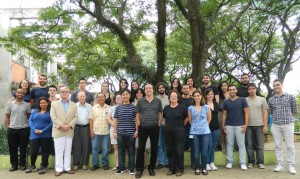
LEM-IQUSP-2014 – Know our Scientific Tree, clique aqui.

 English
English  Português
Português 
